PACKAGING GUIDELINES
REMEMBER TO ALWAYS USE HEAVY DUTY CORRUGATED BOXES FOR SHIPPING!
 How should I pack my item to be sent by a courier company?
How should I pack my item to be sent by a courier company?
It is very important to ensure that your items are packaged correctly and in accordance with our guidelines. We know how important it is that your parcel arrives safely and undamaged so by packaging your items correctly and carefully gets them off to a good start.
Disclaimer
Eastlines Ltd is committed to providing you with information to ensure as best as possible your shipments are delivered with speed and in good condition.
However, shipments are handled regularly as they pass through a courier network both within the UK and Worldwide so in order to make sure your shipments arrive in the best possible condition the packaging guidelines provided by both us and in some instances the carrier selected by our customer, must be adhered to.
Eastlines Ltd will accept no liability for the packaging advice it provides and our customers remain responsible for ensuring all packaging is adequate for transportation.
Eastlines Ltd also make no assurances that by following our guidelines your parcel will not be damaged during transit.
We reserve the right to reject a claim for damage should the packaging be deemed unsuitable for the transportation of goods through a courier network and will refer such cases to the information provided within our Terms and Conditions.
The Do’s and Dont’s of the parcel packing

Remember that items will get stacked in transit, therefore your packaging may need to support the weight of other packages.
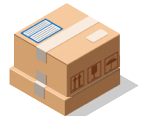

Consider strength, cushioning and durability when selecting your wrapping supplies.


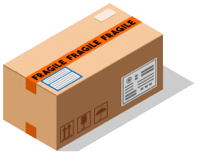











Use heavy-duty double-layered board for fragile items.










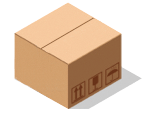


They are only appropriate for information purposes.
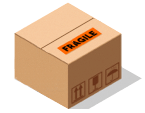

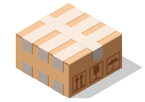

Here are some quick tips to help ensure that your items arrive in perfect condition:
- Wrap each item in the box individually as this will offer better protection of the items whilst in transit. This takes a little longer, but offers better protection because there’s no movement of the contents. Once wrapped place all items within a suitable inner box and seal this shut.
- Consider using polystyrene, bubble wrap and foam wrapping for internal packaging to prevent movement in the box.
- Protect your items by packaging them in a strong inner and outer box. Fill the outer box with a layer of polystyrene chips and place the inner box on top then pour more chips around the edges. Ensure the box is filled to its limit and there are not air gaps or pockets of air in the outer box. Shake the outer box to ensure chips have settled and top up till the outer box is full.
- Use strong tape around edges of boxes and packets to seal them securely to prevent damage.
- Use heavy duty/corrugated cardboard boxes for shipping, ideally a new one. Always use strong external packaging. A new and thick corrugated fibreboard / cardboard box with a good quality outer wrapping is recommended. The larger the size and weight of an item, the thicker and larger the outer box should be. Always make sure the cardboard box allows adequate clearance for sufficient internal packaging to be used on the item(s) being sent. Sub-standard and previously damaged cartons can cause problems and a compensation claim for damage of contents will be deemed invalid if the parcel is inadequately packed or if the inner and outer packaging is not retained for verification.
- Ensure that the address details cannot be smudged or liable to water damage and customs docs are securely fastened
- Remember it is your responsibility to reduce the chance of damage in transit, courier networks are huge carrying masses of parcels so be sure to pack it as best you can to reduce the risk of any issues.
- Don’t think that just because your parcel is being sent next day or same day that you don’t need any extra packaging. An extra few minutes wrapping and securing your item can save an hour or more sorting out a claim with the protection cover policy that often comes with a delivery order.
An important recent issue that has come up has been customers using old boxes, with old labels and stickers on. This is no problem as long as the box is still sturdy and not damaged but what can cause the courier’s confusion is when in some instances dangerous goods labels are left on boxes, meaning the goods are held or can be sent back. Old address labels or customs documents may mislead drivers or people handling the parcel.
Please remove any old documentation, labels or stickers on a reused box to avoid an unwanted headache with your parcel/package delivery.
To prevent movement of items in transit please ensure that multiple items within a parcel do not touch.
Place the contents in a firm cardboard box that is closed and cannot come open during transit.
Internal packaging must always be used as cushioning to:
- Prevent any damage from shock, vibrations, impacts and pressure during transit
- Prevent items within a parcel from touching
- Eliminate any internal movement of a parcels contents
- Provide clearance from the item and the external packaging
If the internal packaging of an item is not sufficient even the best external packaging can be rendered inadequate.
Good examples of internal packaging materials are:
- Bubble wrap
- Foam sheeting
- Polystyrene surrounds and ends – minimum for electrical goods
- Moulded and shaped foam
- Cardboard – used as support structures
- Polystyrene peanuts / chips
Bad examples of internal packaging are:
- Paper – rolled, scrunched or shredded
- Polythene bags/bin liners
- Wood shavings / sawdust
Bubble wrap
Bubble wrap is a good packaging material for providing a cushion to protect against shock.
Always wrap each item individually and place in a separate strong container, this is to prevent items colliding during transit and any shocks or vibrations to the parcel damaging the internal contents.
Always use enough bubble wrap to make sure that the contents of your parcel cannot move when you shake the box. For heavy items bubble wrap should only be used for cosmetic protection. Ensure several layers are used as cushioning to prevent damage to weak areas of the item.
Bubble wrap grades
Bubble wrap is available in several standard grades.
Below is a list of the standard grades and recommended manufacturers uses as packaging:
- 1/16 inch – surface protection. Packaging of light weight products
- 1/8 inch – surface protection. Packaging of medium weight products. May be used as protective wrap
- 3/16 inch – packaging of light to medium weight products. May be used as protective wrap
- 5/16 inch – packaging medium weight items. Ideal for filling voids or blocking and bracing in items in parcels
- 1/2 inch – packaging heavy weight items. Ideal for filling voids or blocking and bracing in items in parcels
Foam Sheeting
Foam sheeting provides excellent cosmetic / exterior protection and cushioning properties. It is ideal when shipping lightweight items.
Polystyrene peanuts / chips
Polystyrene peanuts are pieces of expanded polystyrene which can be used to fill empty spaces in packages with lightweight items. They can also be used when double boxing items (especially electrical goods) as good protection against shocks and vibration as well as eliminating movement of a packaged and boxed item within another larger stronger box is important.
If using Polystyrene chips ensure the box is filled to its limit and there are not air gaps or pockets of air in the outer container. Shake the external packaging to ensure chips settle and top up till the outer container is full.
Polystyrene blocks / surrounds
Polystyrene surrounds should be used on all electrical goods. Make sure the polystyrene blocks suspend and do not allow movement of the item.
Always use strong external packaging. A new and thick corrugated fibreboard / cardboard box with a good quality outer wrapping is recommended. The larger the size and weight of an item, the thicker and larger an outer box should be used.
Always make sure the cardboard box allows adequate clearance for sufficient internal packaging to be used on the item(s) being sent. Sub-standard and previously damaged cartons can cause problems and a compensation claim for damage of contents will be deemed invalid if the parcel is inadequately packed or if the inner and outer packaging is not retained for verification.
Bad examples of external packaging are:
- Shrink wrap
- Bubble wrap
Good examples of external packaging are:
- A high standard fibreboard / cardboard box
- A good condition wooden crate that can be sealed shut
- A good condition plastic box / tube that’s able to be sealed
- A good condition metal case / tin that can be sealed shut
Cardboard boxes lose their strength and rigidity after transporting heavy items through a postal network and if used once they it’s not advisable to use them again for shipping purposes.
Use a wooden crate if necessary. Larger and heavier items may be better protected in a cardboard box and wooden crate than a cardboard box alone.
It’s advised that when shipping all heavy stoneware items, sculptures or large pottery pieces to first package the item in industrial bubble wrap and polystyrene surrounds and then place in a strong cardboard box filled with air cushions or foam chips to suspend the packaged item.
The cardboard box should then be placed in a wooden crate to support the weight of the object and avoid the cardboard box splitting open during transit.
Seal the parcel well. Seal all open edges of the parcel with 48mm/50mm wide plastic or reinforced carton tape on both the top and bottom of your package. Ordinary household adhesive tape isn’t usually strong enough. For heavier items you’ll need a strong outer carton, closed with tape. String around boxes is not suitable as this can get caught and cause damage.
Do not strap multiple boxes together!
This may cause them to become damaged. Either place all items in one large outer carton or send them in separate parcels. We will not pay compensation for loss on parcels that are strapped together.
Provide clear and accurate addressing
Make sure all the address information including telephone number and postcode is in the documentation. This should be completed accurately and firmly attached. Please also ensure that the service barcode labels are securely attached to the parcels and clearly visible.
Using the largest facing surfaces, length is the longest dimension and width the shortest. Height is measured at right angles to the largest surface.
Volumetric weight may be the contributing factor in the price displayed so it’s vital that the correct measurements are recorded and entered at the time of booking.
Items not considered correctly packaged may be refused collection or returned to the sender at a later date following further inspection by the courier concerned.
Packaging advice for specific items
When sending printers, ink cartridges must be removed from the printer and packaged separately in a manner that cannot contaminate any other item. Contents should be placed in a rigid cardboard box and sealed to prevent opening during transit. Please note that printers and printer cartridges are prohibited for International shipping.
Please ensure that all electrical items are secured within the outer packaging using travelling screws and / or poly block surrounds. Using the original retail packaging is a good starting point for electrical items, but further packaging will usually be needed.
The best way to despatch electronic items is to used the original manufacturers packaging as a starting point and then adding further packaging for protection.
Packing the unit:
- Place the electrical item in thick polystyrene blocks that do not allow any movement of the unit in the cardboard box you are using as outer packaging
- Wrap the exposed areas of the unit in minimum 2 inches of bubble wrap
- Place the packaged unit in your cardboard box and seal with thick tape
- Fill your outer box with a layer of polystyrene chips and place the inner box on top, pouring more chips around the edges to eliminate any movement
- Make sure the outer box has adequate clearance around all sides, top and bottom of the inner box
- Ensure the outer box is filled to its limit and there are no air gaps in the foam chips
- Shake the external packaging to ensure chips have settled and top up until the outer container is full
- Seal the box with multiple layers of thick tape
Packaging for electrical / electronic items should always include:
- Thick polystyrene surrounds
- Strong outer fibreboard / cardboard box
- Bubble wrap in a sufficient quantity to absorb impact
- All cables and accessories must be sufficiently packaged if despatched in the same box as the main unit and remote controls must be wrapped in bubble wrap and separately boxed
- Also ensure all batteries are removed before despatch
If suitcases or outer hard cases are used as outer packaging, then that outer packaging itself will not be covered for damage.
Remove the wheels and pedals from the main frame of the bicycle. Wrap the pedals securely in bubble wrap.
Place a sheet of thick cardboard between the wheels and wrap them securely with thick bubble wrap. Ensure that the whole bicycle frame is wrapped in thick bubble wrap.
Place bicycle into a strong cardboard box. Ensure that the box is strong enough to withstand the weight of the contents.
Use polystyrene blocks or internal packaging to ensure the bicycle cannot move during transit.
Wrap heavy / hardback books in multiple layers of bubble wrap and seal with packaging tape. Stack the books in a cardboard box which has no spaces and allows no movement of the books.
If needed place sheets of thick cardboard between the books and on the top and bottom of the books to remove space in the parcel and for added protection.
Computers, monitors and printers, are complex, fragile and sensitive pieces of electrical equipment and as such must be packed adequately to protect them from shock and vibration that occurs during transit.
Computer manufacturers packaging is usually designed for one of the following:
- To ship the product once
- For the storage of the item and therefore must not be used as outer packaging
- For the bulk shipping of multiple items on a pallet and not for single despatch through an automated network, therefore it may not withstand shock and vibration associated with transportation
Reusing packaging weakens the packaging and increases the chance damage may occur. Therefore the original manufactures packaging must only be used as internal packaging.
Before packaging computer equipment please ensure that:
- All screws on PCI/AGP cards are tightened
- All screws on CD/DVD and floppy disc drives are tightened
- All discs are removed from drives
- All peripherals, USB and power cables are removed from the main unit
- The Power supply screws are tightened
- The processor heat sink and fan are securely attached
It’s recommended that you also pack anti static bubble wrap around the heat sink to eliminate any movement during transit.
Recommendations when packing the unit:
- Place the main unit/tower in large polystyrene surrounds. If these were part of the computers original packaging ensure these are used as they are designed specifically for the computer purchased
- Ensure the polystyrene blocks used have no breaks or parts missing which could allow movement when boxed
- Industrial thickness bubble wrap (1/ 2 inch grade) can also be used in multiple layers around any exposed areas of the tower to ensure a secure fit when placed into an outer cardboard box
Inner box:
- Place the computer and polystyrene blocks inside a very strong, multiple walled corrugated cardboard box
- Ensure the cardboard box is new or has no creases, tears or breaks
- Ensure the box allows no movement of the polystyrene blocks and computer
- Seal the box well with multiple layers of 2 inch thick adhesive tape to ensure it cannot open
Outer box:
- Once the computer has been packaged boxed and sealed, it should then be placed in a larger outer box filled with polystyrene chips
- Make sure the outer box has adequate clearance around all sides, top and bottom of the inner box
- Fill the box with a layer of polystyrene chips and place the inner box on top then pour more chips around the edges
- Ensure the box is filled to its limit and there are not air gaps or pockets of air in the outer box
- Shake the outer box to ensure chips have settled and top up till the outer box is full
- Seal the box with multiple layers of thick tape
Small precision made engine parts such as gears, valves, pistons, piston rings, fly wheels etc require sufficient internal packaging to avoid any damage which may render the parts unusable.
Any sharp edges must be covered to ensure they cannot pierce the outer shipping container.
Use folded layers of bubble wrap, thick cardboard or polystyrene chips as internal packaging.
These items then must be packaged in a strong double walled corrugated cardboard / fibreboard box, strong enough to withstand both the weight of the item(s) and all leaflets / documentation..
When despatching documentation line up the stack of documents and strap in bundles that are then wrapped in polythene to avoid a central centre of mass in external packaging.
Stack the bundles and place in a cardboard box, make sure there are no spaces in the outer box which can allow movement of the contents.
Make sure the box used is strong enough to contain the documents and if necessary double box the documents.
Always ensure parcels containing documents are very well sealed, use multiple layers of thick, wide, strong tape.
Do not despatch documents / leaflets wrapped only in paper or in a cardboard box which cannot withstand the weight of the contents or may tear open during transit.
All powder must be placed in a strong, leak-proof container.
The container must then be placed in a strong outer container.
Screw type lids or covers should have rubber/ cork washers.
Friction-top covers must be fastened with metal clips.
Close the container and tape the cover seam with reinforced tape.
Wrap the container in a fully sealable strong plastic bag or plastic sheeting.
If plastic sheeting is used tightly seal all seams with reinforced tape.
Package the sealed inner container(s) in a strong outer box.
Seal the box with multiple layers of thick tape.
Musical instruments must always be despatched in a hard case designed for the item sent and all strings must be loosened or removed.
If necessary, use packaging within the instrument case to ensure the item cannot move during transit.
The hard case should then be packaged in a thick cardboard box or wooden case with sufficient internal soft packing to prevent any movement to the case.
Keyboards must be packaged in accordance with our guidelines for electrical equipment.
Polystyrene surrounds and a thick multiple walled corrugated cardboard box must be used as a minimum for packaging.
Guitars must be placed in a sealable hard case designed for the instrument.
If needed, use bubble wrap around the body and neck to eliminate any movement.
Close the case and make sure all latches are securely closed. Use strong tape to ensure the case cannot open due to the weight of the guitar.
Place the guitar case within a strong double walled corrugated cardboard or fibreboard box.
Use polystyrene blocks or internal packaging to ensure the case cannot move inside the box during transit.
Seal the box with multiple layers of thick tape.
Due to their heavy weight, nuts, bolts, small machine parts etc are able to burst even strong packing.
Such items should be packaged in very thick plastic bags in small quantities to eliminate the chance of bursting due to movement during transit.
Place the item between two sheets of card which are larger around each edge.
Roll the item and 2 layers of card into a cylinder.
Insert the rolled item and card into a strong plastic or cardboard cylindrical mailing tube.
Place cushioning material at either end of tube to eliminate movement and protect the item.
Place plastic lid seals on each end of the tube and seal with multiple layers of strong tape.
For further protection wrap the tube in multiple layers of bubble wrap and place the tube into a cardboard box.
